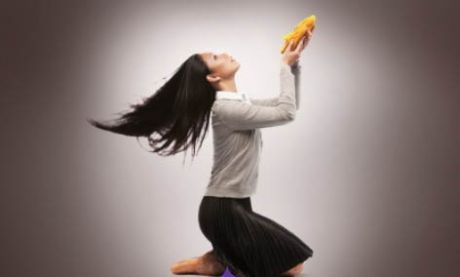Arts
You are here
Going Home Star: ballet recognizes Truth and Reconciliation

February 16, 2016
One can’t help but admire the dedication, athletic beauty and technical skill of classical ballet and modern dancers. But to look for dance performances that contain any kind of real meaning will take you a long time. Classical ballet seems to have improbable sappy romance as its focus, and most modern dance takes abstraction to literally mind-numbing levels.
So it was hugely satisfying to attend a recent performance in Toronto of the Royal Winnipeg Ballet (RWB) entitled “Going Home Star – Truth and Reconciliation.” The dance is based on a story by the renowned Indigenous author Joseph Boyden about First Nations people building on their traditional strength to recover from the ravages of residential schools.
You knew you were in for something culturally different the minute you walked into the Sony Centre and saw a sign in one corner of the building with the text “Elders Corner.” The dance was introduced by the Northern Cree Singers from Manitoba. The musical score was phenomenal and featured award-winning Inuk throat-singer Tanya Tagaq. Cree activist and former MP Tina Keeper, an Honourary Witness at the Truth and Reconciliation Commission hearings, is the associate producer.
Justice Murray Sinclair, Chair of the Truth and Reconciliation Commission of Canada, states in the program notes, “Works of art such as this are so instrumental to breathing life into difficult and complex subjects. I commend the Royal Winnipeg Ballet’s courageous and beautiful interpretation of the Commission’s Work.”
The story begins with a First Nations woman, Annie, who lives in a big city, running a hair salon and, while enjoying an active social life, begins to feel alienated from the whole scene. During a subway commute, she meets Gordon, a homeless First Nations man taken into residential school and now surviving on the streets, and acting as the traditional “trickster” in the story. Through visions, they witness the abuse of two children in a residential school, Niska and Charlie, at the hands of clergymen running the school. Annie and Gordon easily mock the incompetence of Turtle Island’s early European explorers, people who depended for their lives on the generosity and knowledge of First Nations, but who came to exploit their indigenous hosts. Eventually, Gordon follows Annie’s lead and decides to burn the residential school “reliquary” (a small replica of a school).
The core message is that reconciliation begins with the truth, one hidden from most Canadians by successive governments and church bodies to deny the numerous attempts to eliminate or assimilate Indigenous peoples.
The dance has not been without controversy, however, since there are no Indigenous dancers in the performance. In fact there are no First Nations dancers in the RWB. Quoted in the Globe & Mail, Keeper states “The RWB was totally committed to this project in the true sense of reconciliation. We knew from the beginning that we didn’t want to do fusion. We wanted to make a ballet…The question was: How do we find a way to tell a native story while sticking strictly to the ballet form? It was a really fulsome experience.”
The lack of Indigenous dancers is largely a result of the lack of access to and affordability of training, not to mention cultural differences. Dance companies have some bursaries and other supports but participation by Indigenous peoples remains an issue. There are notable exceptions: Maria Tallchief was the first major American prima ballerina and George Balanchine’s first muse—a dancer who was also member of the Osage Nation.
That important question aside, the dance is really worth seeing. The RWB is on tour with upcoming performances throughout western Canada in March and April. See rwb.org.
Section:
Topics:










